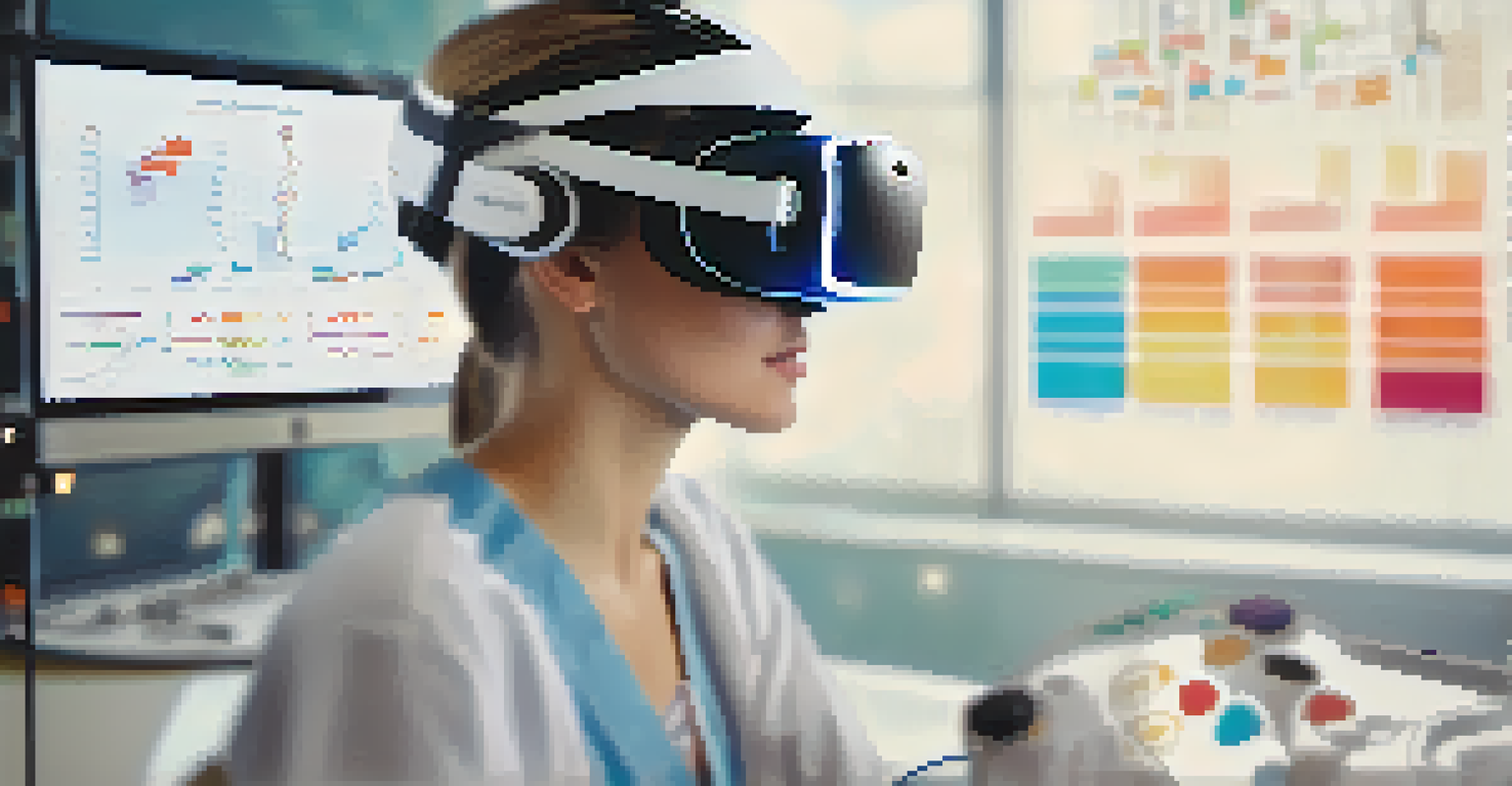Virtual Reality: Transforming Physical Rehabilitation Therapy

Understanding Virtual Reality in Rehabilitation Therapy
Virtual reality (VR) is a technology that immerses users in a computer-generated environment. In the context of rehabilitation therapy, it offers a unique and engaging way for patients to participate in their recovery. By simulating real-world scenarios, VR can help patients regain skills and improve physical function.
Virtual reality is not just a technology; it's a new way to connect with patients and enhance their healing journey.
One of the key benefits of VR in rehabilitation is its ability to create controlled, repeatable environments where patients can practice movements safely. For instance, a stroke patient can use VR to practice walking in a virtual park without the risks associated with real-world walking. This innovative approach not only enhances engagement but also provides valuable feedback for therapists.
Additionally, VR can be tailored to meet individual patient needs, making it a versatile tool in therapy. With customizable settings, therapists can adjust difficulty levels and scenarios, ensuring that each patient receives a rehabilitation experience that is both challenging and enjoyable.
Benefits of Virtual Reality in Physical Rehabilitation
One of the standout advantages of VR in rehabilitation is increased motivation among patients. Traditional rehabilitation can sometimes feel monotonous, but the immersive nature of VR makes exercises more engaging. Imagine a patient who is recovering from an injury playing a fun game while simultaneously working on their range of motion - it’s a win-win situation!

Moreover, VR offers real-time feedback, allowing patients to see their progress instantly. This immediate reinforcement can boost confidence and encourage them to push through challenging exercises. For example, a patient might see their balance improve through a virtual balance game, motivating them to continue their work.
VR Enhances Rehabilitation Engagement
Virtual reality transforms rehabilitation therapy by making exercises more engaging and enjoyable for patients.
Finally, the technology can provide therapists with valuable data on patient performance. By analyzing this information, therapists can fine-tune treatment plans and track improvements over time, leading to more informed decisions about patient care.
Case Studies: Success Stories with VR Therapy
Numerous case studies highlight the success of VR in rehabilitation settings. For instance, a study involving stroke patients showed that those who participated in VR therapy experienced faster recovery times compared to those who followed traditional methods. This finding underscores the potential of VR to enhance rehabilitation outcomes.
The future of rehabilitation lies in innovative technologies that empower patients to take charge of their recovery.
Another compelling example comes from a rehabilitation center that integrated VR into their treatment programs for patients with spinal cord injuries. Patients reported feeling more engaged and less anxious during therapy sessions, leading to improved results in strength and mobility. These stories exemplify how VR can make a real difference in recovery journeys.
These success stories are not just anecdotal; they are backed by research and patient testimonials. As more rehabilitation centers adopt VR technology, we can expect to see even more positive outcomes and improvements in patient care.
Challenges in Implementing VR in Therapy
Despite its many advantages, implementing VR in rehabilitation therapy does come with challenges. One of the main hurdles is the cost of the technology, which can be a barrier for some clinics. However, as technology advances, prices are gradually decreasing, making it more accessible over time.
Another challenge is the need for clinicians to be trained in using VR systems effectively. While the technology may be intuitive, understanding how to integrate it into existing treatment protocols requires specialized knowledge. Ongoing training and support for therapists are crucial to ensure successful implementation.
Real-Time Feedback Boosts Recovery
The immediate feedback provided by VR helps patients track their progress, boosting confidence and motivation during therapy.
Lastly, it’s important to consider the individual needs of patients. Not everyone may feel comfortable using VR, and some patients may experience motion sickness or anxiety during sessions. Finding a balance between encouraging patients to try new technologies and respecting their comfort levels is essential.
The Role of Gamification in VR Rehabilitation
Gamification, or the use of game-like elements in non-game contexts, plays a significant role in VR rehabilitation. By incorporating game mechanics into therapy, patients are more likely to stay engaged and motivated. This can be as simple as earning points for completing exercises or competing against others in a virtual environment.
For example, a patient recovering from a knee injury might play a VR game where they navigate an obstacle course, requiring them to bend, stretch, and strengthen their knee. This not only makes therapy enjoyable but can also lead to better adherence to rehabilitation programs.
Furthermore, gamification allows for social interaction, which can enhance the rehabilitation experience. Patients can connect with others undergoing similar challenges, fostering a sense of community and support that can be incredibly beneficial during recovery.
Future Trends in Virtual Reality Rehabilitation
The future of VR in rehabilitation therapy looks promising, with continued advancements in technology paving the way for innovative treatments. As VR becomes more sophisticated, we can expect even more realistic environments and scenarios that can mimic real-life challenges patients face. This will enhance the therapeutic value and effectiveness of rehabilitation programs.
Moreover, the integration of artificial intelligence (AI) with VR could personalize therapy even further. Imagine a VR system that adapts in real-time based on a patient’s performance, providing customized challenges and support. This could lead to more tailored rehabilitation experiences and improved outcomes.
Future of VR Looks Promising
Advancements in VR technology and potential integration with AI promise to further personalize and enhance rehabilitation experiences.
Finally, as research continues to emerge, we may see more widespread acceptance of VR therapy in mainstream healthcare. With proven efficacy and growing popularity, VR could become a standard component of rehabilitation programs across the globe.
Conclusion: Embracing the Future of Rehabilitation
In conclusion, virtual reality is revolutionizing physical rehabilitation therapy in exciting ways. By making therapy more engaging and personalized, it has the potential to improve patient outcomes and satisfaction significantly. As we embrace this technology, it’s essential to continue exploring its possibilities and refining its implementation.
The success stories we've seen so far are just the tip of the iceberg. As more healthcare professionals recognize the benefits of VR, we can expect to see its integration grow, offering new hope to patients on their recovery journeys. The collaboration between technology developers, therapists, and patients will be key to maximizing the potential of VR in rehabilitation.

Ultimately, as we look to the future, it's clear that virtual reality has the power to transform lives. By making rehabilitation more effective and enjoyable, we are not just treating injuries but also empowering patients to regain control of their lives.